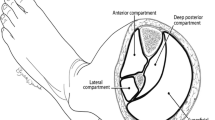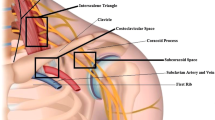Abstract
The lateral abdominal wall is comprised of three muscles, each with a different function and orientation. The transversus abdominus, internal oblique, and external oblique muscles span the abdominal cavity between the iliocostalis lumborum and quadratus lumborum posteriorly and the rectus abdominis anteriorly. The lateral abdominal wall is bound superiorly by the lower ribs and costal cartilages and inferiorly by the iliac crest and inguinal ligament. The lateral abdominal wall may be acutely or chronically injured in a variety of athletic endeavors, with occasional acute injuries in the setting of high-energy trauma such as motor vehicle collisions. Injuries to the lateral abdominal wall may result in lumbar hernia formation, unique for its high incarceration rate, and also Spigelian hernias. This article will review the anatomy, the magnetic resonance (MR) imaging approach, and the features and complications of lateral abdominal wall injuries.












Similar content being viewed by others
References
Baumann DP, Butler CE. Lateral abdominal wall reconstruction. Semin Plast Surg. 2012;26(1):40–7.
Stevens KJ, Crain JM, Akizuki KH, Beaulieu CF. Imaging and ultrasound-guided steroid injection of internal oblique muscle strains in baseball pitchers. Am J Sports Med. 2010;38(3):581–5.
Maquirriain J, Ghisi JP. Uncommon abdominal muscle injury in a tennis player: internal oblique strain. Br J Sports Med. 2006;40(5):462–3.
Connell DA, Jhamb A, James T. Side strain: a tear of internal oblique musculature. AJR Am J Roentgenol. 2003;181(6):1511–7.
Chim H, Evans KK, Salgado CJ, Mardini S. Abdominal wall anatomy and vascular supply. In: Rosen MJ, editor. Atlas of abdominal wall reconstruction. 1st ed. Philadelphia: Saunders; 2012.
Obaid H, Nealon A, Connell D. Sonographic appearance of side strain injury. AJR Am J Roentgenol. 2008;191(6):W264–7.
Emery CA, Meeuwisse WH, Powell JW. Groin and abdominal strain injuries in the National Hockey League. Clin J Sport Med. 1999;9(3):151–6.
Humphries D, Jamison M. Clinical and magnetic resonance imaging features of cricket bowler’s side strain. Br J Sports Med. 2004;38(5), E21.
Anderson KD, Strickland SM, Warren R. Hip and groin injuries in athletes. Am J Sports Med. 2001;29(4):521–33.
Clain A. Traumatic hernia. Br J Surg. 1964;51:549–50.
Blazina ME. The “Hip pointer”. Calif Med. 1967;106(6):450.
Geis WP, Hodakowski GT. Lumbar hernia. In: Nyhus L, Condon R, editors. Hernia. 5th ed. Philadelphia: Lippincott William & Wilkins; 2001.
Esposito TJ, Fedorak I. Traumatic lumbar hernia: case report and literature review. J Trauma. 1994;37(1):123–6.
Burt BM, Afifi HY, Wantz GE, Barie PS. Traumatic lumbar hernia: report of cases and comprehensive review of the literature. J Trauma. 2004;57(6):1361–70.
Guly HR, Stewart IP. Traumatic hernia. J Trauma. 1983;23(3):250–2.
Lane CT, Cohen AJ, Cinat ME. Management of traumatic abdominal wall hernia. Am Surg. 2003;69(1):73–6.
Itani KMF, Zare SM. Uncommon abdominal wall hernias. In: Bland KI, Sarr MG, Buchler MW, Csendes A, Garden OJ, Wong J, editors. General surgery: principles and international practice. 2nd ed. London: Springer; 2009.
Moreno-Egea A, Baena EG, Calle MC, Martinez JA, Albasini JL. Controversies in the current management of lumbar hernias.
Gil-Galindo G, Romero-González RJ, Flores-Salinas MA, Romero-González R, Pulido-Rodríguez J. Giant Spigelian hernia and abdominal trauma: cause or coincidence? Cir Cir. 2012;80(2):189–92.
Combs JA. Hip and pelvis avulsion fractures in adolescents. Phys Sports Med. 1994;22:41–9.
Micheli LJ, Fehlandt AF. Overuse injuries to tendons and apophyses in children and adolescents. Clin Sports Med. 1992;11(4):713–26.
Rossi F, Dragoni S. Acute avulsion fractures of the pelvis in adolescent competitive athletes: prevalence, location and sports distribution of 203 cases collected. Skeletal Radiol. 2001;30(3):127–31.
Stevens MA, El-khoury GY, Kathol MH, Brandser EA, Chow S. Imaging features of avulsion injuries. Radiographics. 1999;19(3):655–72.
Sanders TG, Zlatkin MB. Avulsion injuries of the pelvis. Semin Musculoskelet Radiol. 2008;12(1):42–53.
Li X, Xu S, Lin X, Wang Q, Pan J. Results of operative treatment of avulsion fractures of the iliac crest apophysis in adolescents. Injury. 2014;45(4):721–4.
Hébert KJ, Laor T, Divine JG, Emery KH, Wall EJ. MRI appearance of chronic stress injury of the iliac crest apophysis in adolescent athletes. AJR Am J Roentgenol. 2008;190(6):1487–91.
Outerbridge AR, Micheli LJ. Overuse injuries in the young athlete. Clin Sports Med. 1995;14(3):503–16.
Clancy WG, Foltz AS. Iliac apophysitis and stress fractures in adolescent runners. Am J Sports Med. 1976;4(5):214–8.
Frush TJ, Lindenfeld TN. Peri-epiphyseal and overuse injuries in adolescent athletes. Sports Health. 2009;1(3):201–11.
Dragoni S, Giombini A, Di Cesare A, Ripani M, Magliani G. Stress fractures of the ribs in elite competitive rowers: a report of nine cases. Skeletal Radiol. 2007;36(10):951–4.
De Maeseneer M, De Mey J, Lenchik L, Everaert H, Osteaux M. Helical CT of rib lesions: a pattern-based approach. AJR Am J Roentgenol. 2004;182(1):173–9.
Mcdonnell LK, Hume PA, Nolte V. Rib stress fractures among rowers: definition, epidemiology, mechanisms, risk factors and effectiveness of injury prevention strategies. Sports Med. 2011;41(11):883–901.
Karlson KA. Rib stress fractures in elite rowers. A case series and proposed mechanism. Am J Sports Med. 1998;26(4):516–9.
Daffner RH, Pavlov H. Stress fractures: current concepts. AJR Am J Roentgenol. 1992;159(2):245–52.
Author information
Authors and Affiliations
Corresponding author
Ethics declarations
Source of founding
None.
Conflict of interest
No grants or conflict of interests to disclose.
Rights and permissions
About this article
Cite this article
Stensby, J.D., Baker, J.C. & Fox, M.G. Athletic injuries of the lateral abdominal wall: review of anatomy and MR imaging appearance. Skeletal Radiol 45, 155–162 (2016). https://doi.org/10.1007/s00256-015-2261-y
Received:
Revised:
Accepted:
Published:
Issue Date:
DOI: https://doi.org/10.1007/s00256-015-2261-y




